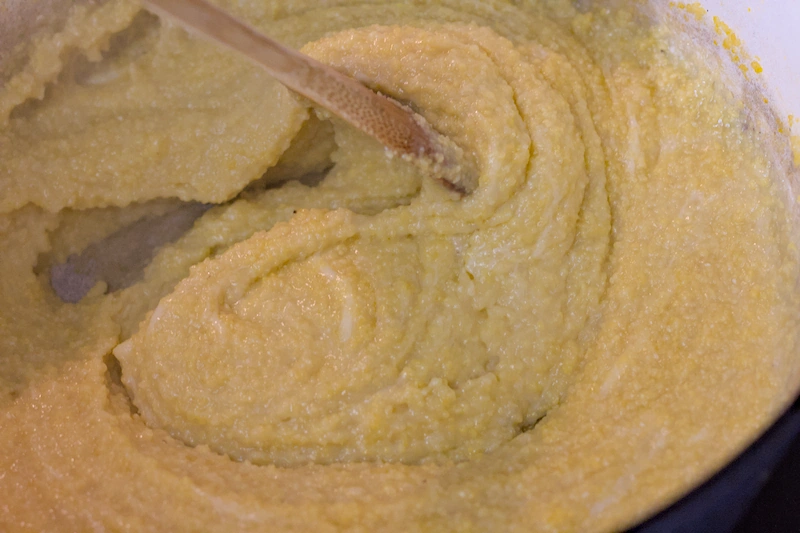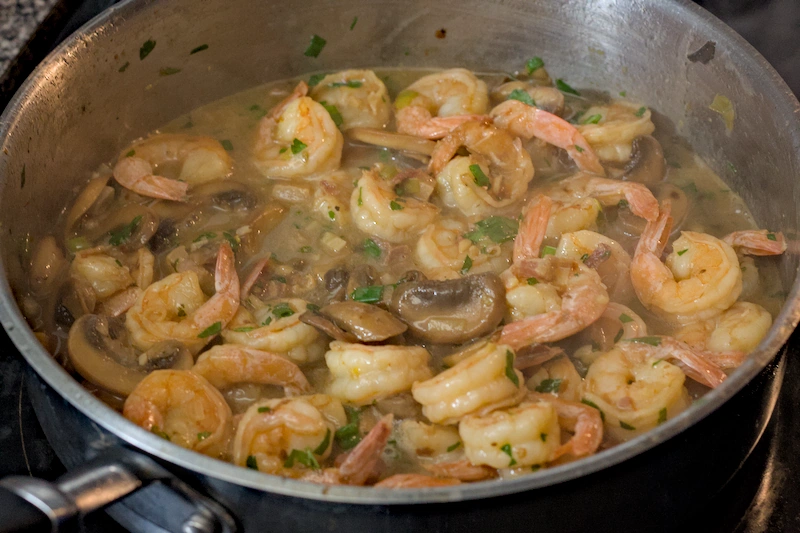Shrimp Scampi and Grits, Plus a Lesson in Project Management

If there’s one thing that Southerners and Italians agree on, it’s cornmeal. Grits are a symbol of the South, and polenta is a staple of northern Italy. The exact difference is unclear, but that won’t stop eyebrows being raised (or worse) if you try to use one in place of the other–if there’s a second thing Southerners and Italians agree upon, it’s getting upset when some upshot tries to mess with their dishes. We’re going to make everyone mad, then, by taking coastal Southern icon shrimp and grits and mashing it up with Italian-American classic shrimp scampi. To appease the angry masses, though, I’ve got some tips on how to plan things out so you can do 2 hours of cooking in just half the time.
Grits and Pieces
Let’s start by going over the components of the dish. Shrimp and grits is a fairly mutable dish, but common components (besides the obvious two) include bacon or ham, mushrooms, cheese in the grits, and sliced scallions on top. It’s usually somewhat saucy, with a sort of light gravy made from thickened stock. We’re going to be taking these components and remaking them in the image of shrimp scampi, whose flavor profile is largely composed of wine, garlic, parsley, butter, and lemon.
The sauce is where we’ll make most of our hybridization efforts. We’re keeping the stock, but adding vermouth (for a more concentrated wine flavor), crushed red pepper, and some additional garlic and butter, along with some parsley in the herb garnish. We’re also swapping the bacon for pancetta and using fontina and parmesan cheese in the grits/polenta, not because you’re likely to find them in shrimp scampi, but rather to adapt some of the shrimp and grits elements to better fit the Italian flavor profile we’re building.

There are a couple steps we’re taking to improve the final dish: first, we’re going to marinate the shrimp in baking soda and salt. This keeps them plump and flavorful, and there’s a noticeable difference after as little as 30 minutes. We’re also adding some cornstarch to the shrimp at this point, both to keep them from releasing too much water as they sear and to help thicken the final sauce as they finish cooking together. We’re also taking some time to use shell-on shrimp and reinforcing the chicken stock we’re using with the shells, along with the mushroom stems and any other bits we have as we prep the rest of the ingredients. Both these steps take a fair amount of time, though, and that’s not counting the hour or so we need to cook the grits. If we’re looking to get this on the table on a typical weeknight, we’re going to need to come up with a plan.
Gantt Stop Me Now
Let’s think about each step and the order we’ll do them in. The normal way you’d approach this dish, if you’re doing one thing at a time, might look something like this:
This is a Gantt chart: a timeline running left to right, with blocks representing individual tasks, their relative order, and how long they take. So in this chart, the first task is preparing your mise en place–get everything out, shred your cheese, measure your stock, and so on. Then prepare your mushrooms and herbs, peel the shrimp and mix them with their marinade, and so on. Tasks that are carried out in parallel are stacked, so you can see the shrimp marinates at the same time as making the stock and grits. I don’t necessarily recommend drawing up one of these whenever you’re making dinner, but it’s a useful way to plan complex tasks (or meals). Consider this approach next Thanksgiving.
This order of operations for the recipe is pretty straightforward, but you can see that half the time is spent just standing at the stove stirring your pot of grits. You can’t start the grits until the stock has been simmered with the shrimp shells and such, and you can’t start that until the shrimp are peeled and your vegetables, herbs, mushrooms, and such are all prepped. What’s more, since you’re stirring the grits constantly, you can’t even start cooking the shrimp and sauce until that’s done and you’re freed up. Put this all together, and you’re looking at over 2 hours of cooking. Let’s see a few ways we can speed things up, even if we can’t reduce the time each individual task takes.
Project Management for Hungry People
The biggest thing first: you don’t need to stir grits constantly. I’m not sure why people say you do. Just give things a good whisk every couple minutes and make sure things aren’t sticking to the bottom of your pot, and you’re good. This frees you up immensely: feel free to work on the other components as the grits cook, and as long as you don’t forget about them completely, you should be fine.

The other big time sink here is making the shrimp-infused stock, but with a little creativity we can make this in parallel with some other things. If we only infuse half of the total stock we need for the recipe, we can start cooking the grits with the other half at the same time as we’re infusing the remainder. This works pretty well, though just keep in mind the grits will look thick and pasty until you thin them out with the infused stock later on. Another bit of optimization is that you can start infusing the stock before all your ingredients are actually ready to go. Normally you’d want to prepare all your ingredients before you start cooking, but if you order things correctly you can save some time: peel your shrimp first and get the shells cooking in the stock right away while you wash and slice the mushrooms. Add the mushroom stems as you prep them, and let them simmer while you prep the herbs. Add the herb stems and such as you get everything else ready. Now you’ve got your mise en place¹ ready at the same time as the stock, which is cooking at the same time as the grits. All together, our improved plan is an entire hour faster than before:
In just over an hour, you’ll have savory, lemony shrimp on top of a bowl of cheesy grits (or possibly polenta), in half the time as it would have initially taken. Which gives you plenty of time to hide from the Southerners and Italians who might be tracking you down.

Play Around
If you want to offend the Spanish rather than the Italians, consider a gambas al ajillo version: replace the pancetta with chorizo, the vermouth with sherry, the lemon juice with sherry vinegar (but probably not as much), and the cheeses with Manchego. Add some smoked paprika with the red pepper flakes if you want.
Notes
- French for “hey, maybe make sure to chop that onion before you need it.”
Shrimp Scampi and Grits
Prep List
Equipment
Procedure
| Ingredients | Preparation |
|---|---|
|
1 lb shell-on shrimp 3/4 tsp Diamond Crystal kosher salt 1/4 tsp baking soda 1/2 tsp cornstarch |
1. Drain shrimp of any liquid and blot dry with a paper towel. Peel shrimp, reserving shells in a small saucepan and shrimp in a medium bowl. Add salt, baking soda, and cornstarch to bowl, stir to coat shrimp, and set aside for about 30 minutes. |
|
1 Tbsp olive oil shrimp shells 3 cups (24 oz, 680 g) homemade or low sodium chicken stock mushroom stems herb stems, roots, and trimmings |
2. Meanwhile, add olive oil to pan of shrimp shells and set over medium-high heat. Cook shells briefly until pink, then add stock. Bring to a simmer and cook for 20 minutes, adding mushroom stems, parsley stems, scallion roots, and any other trimmings as you prepare those ingredients. |
|
3 cups homemade or low sodium chicken stock 1 cup (6 3/4 oz, 190g) grits, polenta, or cornmeal |
3. Meanwhile, bring another 3 cups of stock to a boil in a separate large saucepan or Dutch oven. Add grits and whisk to combine. Bring to a gentle simmer and cook, whisking frequently, for 20 minutes. Mixture will resemble a thick batter. |
|
1 Tbsp olive oil 4 oz (115 g) pancetta, diced small |
4. Meanwhile, add olive oil and pancetta to a large saute pan and set over medium heat. Cook until pancetta is brown and fat is rendered, about 5 minutes. Remove pancetta with a slotted spoon and reserve. Drain all but 1 tablespoon fat, reserving excess. |
| 5. Raise heat to high and, when fat is just starting to smoke, add shrimp. Cook for 1 minute on each side, until pink all over but interior remains slightly translucent. Remove shrimp with slotted spoon and reserve. | |
|
10 oz (280 g) button mushrooms, sliced kosher salt freshly ground black pepper |
6. Reduce heat to medium-high, add reserved pancetta fat, heat until shimmering, then add mushrooms. Season lightly with salt and pepper and cook, stirring frequently, until browned. Remove mushrooms with slotted spoon and reserve. Remove pan from heat, but do not wash. |
| 7. Once shrimp shell stock has been simmering for 20 minutes, strain it through a fine mesh strainer into a heatproof measuring cup or bowl. Add 2 cups (475 ml) of stock to grits, 1 cup at a time, whisking thoroughly after each addition to break up any clumps. You should have about 3/4 cup (175 ml) stock remaining. Continue simmering grits for 40 minutes more (1 hour total), whisking frequently. | |
|
1 Tbsp olive oil 6 cloves garlic, minced 2 scallion whites, thinly sliced 1/4 to 1/2 tsp red pepper flakes 1/2 cup (120 ml) dry vermouth |
8. When grits have about 15 minutes left, return saute pan to medium-high heat with olive oil. When shimmering, add garlic, scallion whites, and red pepper flakes and cook until aromatic but not browned, about 30 seconds. Add vermouth and scrape the bottom of the pan with a wooden spoon to deglaze. Cook until raw alcohol smell dissipates and liquid reduces slightly, about 3 minutes. |
|
1 Tbsp lemon juice kosher salt |
9. Add remaining shrimp stock, bring to a boil, and cook for 5 minutes, until liquid is reduced slightly. Add reserved pancetta, mushrooms, and shrimp and heat for 1 minute. Stir in lemon juice and add salt to taste. |
|
3 oz (1 cup, 85 g) fontina cheese, shredded 1 oz (5 Tbsp, 30 g) parmesan cheese, finely grated kosher salt |
10. Once grits are creamy and thick, add cheese and stir until melted. Taste and add salt if needed. Keep over very low heat until ready to serve. |
|
3 Tbsp butter, cut into 1 Tbsp pieces 1 Tbsp lemon zest, finely grated 2 Tbsp parsley, minced 2 scallion greens, thinly sliced |
11. To finish, bring shrimp mixture to a boil. Add butter 1 tablespoon at a time, stirring vigorously to emulsify each piece completely into the sauce before adding next piece. When last piece is emulsified, remove from heat and stir in lemon zest, parsley, and scallion greens. Scoop grits into bowls, top with shrimp and sauce, and serve immediately. |
Notes
Do not use instant grits or polenta here.
To make pescatarian, omit pancetta. Use additional olive oil as needed to saute shrimp and mushrooms.
Leftover grits will solidify as they cool. You can reheat them by slicing the leftovers into slabs and browning them in a nonstick skillet with a little olive oil or butter.